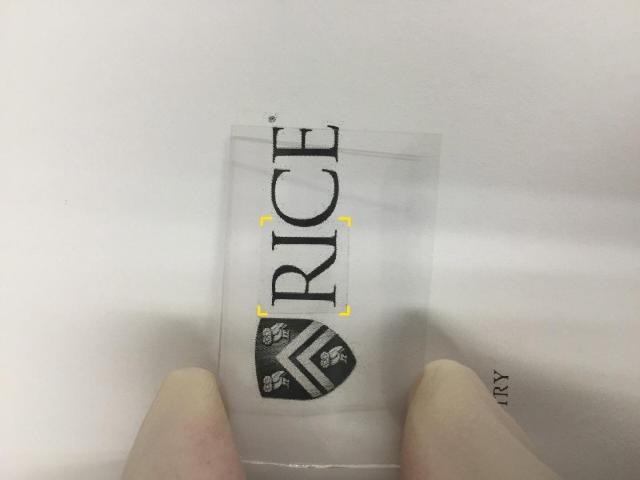Jul 18 2016
Researchers at Rice University state that if graphene had nanoscale “rivets”, then the wonder material’s properties are likely to accelerate its adoption in products such as flexible, transparent electronics.
 Rivet graphene (outlined in yellow) is nearly as transparent as pure graphene and retains its strength and conductivity even when flexed. The material was created at Rice University. (Photo credit: Tour Group/Rice University)
Rivet graphene (outlined in yellow) is nearly as transparent as pure graphene and retains its strength and conductivity even when flexed. The material was created at Rice University. (Photo credit: Tour Group/Rice University)
The creation of “rivet graphene” 2D carbon was reported by the Rice lab of chemist James Tour. This novel material integrates carbon spheres that enclose iron nanoparticles, and carbon nanotubes for strength which improve both portability and electronic properties of the material.
The material has been described in the American Chemical Society’s ACS Nano journal.
Earlier scientist used to export graphene grown using chemical vapor deposition with a polymer layer to prevent it from ripping or wrinkling. The downside was that the polymer left some contaminants behind which degraded the abilities of the graphene to covey current.
Rivet graphene proved tough enough to eliminate the intermediate polymer step. Also, the rivets make interfacing with electrodes far better compared with normal graphene’s interface, since the junctions are more electrically efficient. Finally, the nanotubes give the graphene an overall higher conductivity. So if you want to use graphene in electronic devices, this is an all-around superior material.
Tour
Upon testing, it was proved that the rivet graphene kept the strength of the Tour lab’s rebar graphene with integrated nanotube reinforcement as well as the ability of the rebar to float on water. Furthermore, the rivets improved the ability of the material to export current from electrodes to the graphene, even when bent.
The rivets are carbon layers enveloping a 30-nm iron core, referred to as “nano-onions” by the lab. Using the CVD furnace, the structures are grown in place after the distribution of nanotubes and deposition of graphene. As a last step, all the elements are welded together.
Rivet graphene is adequately transparent for transparent and flexible electronics and the simplified method can be scaled up.
Xinlu Li, a former visiting researcher at Rice and a professor at Chongqing University, China, is lead author of the paper. Co-authors are graduate student Junwei Sha of Rice, Tianjin University, China, and the Collaborative Innovation Center of Chemical Science and Engineering in Tianjin; graduate student Yilun Li, postdoctoral researcher Yongsung Ji and former postdoctoral researcher Seoung-Ki Lee of Rice; and Yujie Zhao of Chongqing. Tour is the T.T. and W.F. Chao Professor of Chemistry as well as a professor of computer science and of materials science and nanoengineering.
The Air Force Office of Scientific Research and its Multidisciplinary University Research Initiative, the Natural Science Foundation Project of China’s Chongqing Science and Technology Commission and the China Scholarship Council funded this research.